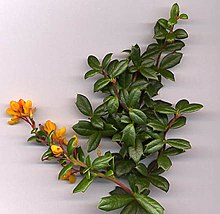Berberidaceae
- View a machine-translated version of the Spanish article.
- Machine translation, like DeepL or Google Translate, is a useful starting point for translations, but translators must revise errors as necessary and confirm that the translation is accurate, rather than simply copy-pasting machine-translated text into the English Wikipedia.
- Do not translate text that appears unreliable or low-quality. If possible, verify the text with references provided in the foreign-language article.
- You must provide copyright attribution in the edit summary accompanying your translation by providing an interlanguage link to the source of your translation. A model attribution edit summary is
Content in this edit is translated from the existing Spanish Wikipedia article at [[:es:Berberidaceae]]; see its history for attribution. - You may also add the template
{{Translated|es|Berberidaceae}}to the talk page. - For more guidance, see Wikipedia:Translation.
| Berberidaceae | |
|---|---|
 | |
| Berberis darwinii shoot with flowers | |
| Scientific classification | |
| Kingdom: | Plantae |
| Clade: | Tracheophytes |
| Clade: | Angiosperms |
| Clade: | Eudicots |
| Order: | Ranunculales |
| Family: | Berberidaceae Juss. |
| Genera | |
| See text | |
The Berberidaceae are a family of 18 genera of flowering plants commonly called the barberry family. This family is in the order Ranunculales. The family contains about 700 known species,[1] of which the majority are in the genus Berberis. The species include trees, shrubs and perennial herbaceous plants.
Taxonomy
The APG IV system of 2016 recognises the family and places it in the order Ranunculales in the clade eudicots.[2]
In some older treatments of the family, Berberidaceae only included four genera (Berberis, Epimedium, Mahonia, Vancouveria), with the other genera treated in separate families, Leonticaceae (Bongardia, Caulophyllum, Gymnospermium, Leontice), Nandinaceae (Nandina), and Podophyllaceae (Achlys, Diphylleia, Dysosma, Jeffersonia, Podophyllum, Ranzania, Sinopodophyllum).
Mahonia is very closely related to Berberis, and included in it by many botanists. However, recent DNA-based phylogenetic research has reinstated Mahonia, though with a handful of species transferred into the newly described genera Alloberberis (formerly Mahonia section Horridae) and Moranothamnus (formerly Mahonia claireae).[3] Species of Mahonia and Berberis can be hybridised, with the hybrids being classified in the genus × Mahoberberis.[4][5]
Diphyllaea is closely related to or perhaps embedded within Podophyllum. Instead of the current trend to subdivide Podophyllum into three genera (Podophyllum, plus Dysosma and Sinopodophyllum), inclusion of Diphyllaea in a larger Podophyllum is equally warranted.
Genera are displayed in the following cladogram
| ||||||||||||||||||||||||||||||||||||||||||||||||||||
| ||||||||||||||||||||||||||||||||||||||||||||||||||||
| Leontice L. (Middle East to Central and Western Asia) | ||||||||||||||||||||||||||||||||||||||||||||||||||||
Gallery
-
 Berberis pinnata (California barberry)
Berberis pinnata (California barberry) -

-
 Berberis darwinii (calafate or michay)
Berberis darwinii (calafate or michay) -
 Berberis empetrifolia, fruit
Berberis empetrifolia, fruit
References
- ^ CHRISTENHUSZ, MAARTEN J.M.; BYNG, JAMES W. (2016-05-20). "The number of known plants species in the world and its annual increase". Phytotaxa. 261 (3): 201. doi:10.11646/phytotaxa.261.3.1. ISSN 1179-3163.
- ^ The Angiosperm Phylogeny Group (2016-05-01). "An update of the Angiosperm Phylogeny Group classification for the orders and families of flowering plants: APG IV". Botanical Journal of the Linnean Society. 181 (1): 1–20. doi:10.1111/boj.12385. ISSN 1095-8339.
- ^ Yu, Chih-Chieh; Chung, Kuo-Fang (2017-12-22). "Why Mahonia? Molecular recircumscription of Berberis s.l., with the description of two new genera, Alloberberis and Moranothamnus". Taxon. 66 (6): 1371–1392. doi:10.12705/666.6.
- ^ "Plants Profile for Mahoberberis". USDA PLANTS. Retrieved 2020-11-17.
- ^ "Puccinia graminis (stem rust of cereals)". Invasive Species Compendium. Centre for Agriculture and Bioscience International. 2019-12-10. Retrieved 2020-11-17.
External links

- Berberidaceae, Leonticaceae, Nandinaceae, Podophyllaceae in L. Watson and M.J. Dallwitz (1992 onwards), The families of flowering plants.
- Berberidaceae links Archived 2008-10-13 at the Wayback Machine
- Chilean Berberidaceae, by Chileflora
- v
- t
- e
- Supergroup Plant:
- Bryophyta
- Marchantiophyta
- Polypodiophyta
- Acrogymnospermae
- Angiospermae
| Amborellales | |
|---|---|
| Nymphaeales | |
| Austrobaileyales |
 Category
Category

















